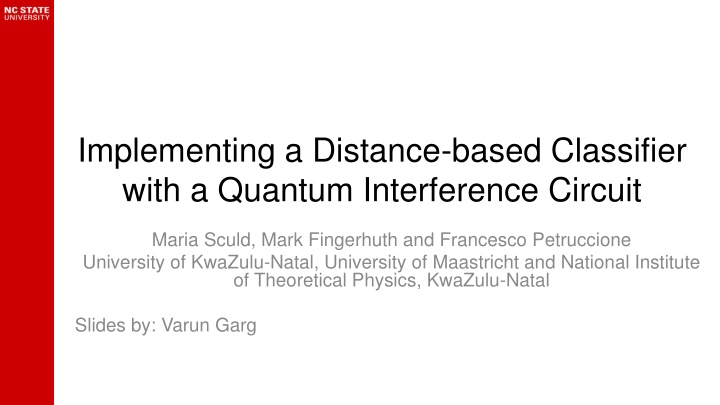
Implementing Distance-based Quantum Classifier with Interference Circuit
"Explore the implementation of a distance-based quantum classifier using an interference circuit, as presented by Maria Sculd, Mark Fingerhuth, and Francesco Petruccione. Learn about the motivation, math involved, interference circuit example, experimental results, and discussions surrounding quantum machine learning algorithms. Dive into the supervised learning approach, dataset preparation, quantum state generation, and transformation to quantum space. Discover how the classifier equation and state preparation lead to quantum-based classification."
Download Presentation

Please find below an Image/Link to download the presentation.
The content on the website is provided AS IS for your information and personal use only. It may not be sold, licensed, or shared on other websites without obtaining consent from the author. If you encounter any issues during the download, it is possible that the publisher has removed the file from their server.
You are allowed to download the files provided on this website for personal or commercial use, subject to the condition that they are used lawfully. All files are the property of their respective owners.
The content on the website is provided AS IS for your information and personal use only. It may not be sold, licensed, or shared on other websites without obtaining consent from the author.
E N D
Presentation Transcript
Implementing a Distance-based Classifier with a Quantum Interference Circuit Maria Sculd, Mark Fingerhuth and Francesco Petruccione University of KwaZulu-Natal, University of Maastricht and National Institute of Theoretical Physics, KwaZulu-Natal Slides by: Varun Garg
Contents Motivation The Math Involved The Interference Circuit Example Experimental Results Discussion
Motivation Current quantum ML algorithms require non-trivial circuits Quantum ML algorithms require amplitude amplification SVMs in quantum require quantum matrix inversion or density matrix exponentiation Current ML algorithms based off classical algorithms Build ML algorithm with Quantum in mind
The Math Involved Use a supervised learning approach Dataset with labels present Labels are binary Classification of unknown points made on distance from points in dataset
The Dataset D = {(x1, y1), (x2, y2), (xM, yM)} xm RN ym {-1,1} x~is the unlabeled input
Classifier Equation Distance from all points calculated ym is the label for mth data point
State Preparation Need to create quantum equivalent of classifier Generate state with dataset points and labels Add input point and calculate probabilities for the labels
Transforming to Quantum Space Now, apply the H gate to the ancilla bit and conditional measure when ancilla bit |0> The H gate will give us the equation of the required form
For the class qubit ym =0, the probability is If vectors are normalized, then
Quantum - Classical Label decided on probability of qubit being 1 or 0 Label is -1 if summation < 0 or 1 if summation > 1
Example X0 and x1 are labeled points as 1 and -1 with 2 features X is the input unlabeled point X has label -1
Circuit Ancilla Index Data Class (Final result)
Circuit Ancilla and Index put into uniform superposition
Circuit The unlabeled x is entangled with the ancilla bit
Circuit x0 is entangled with the ancilla and index qubits
Circuit x1 is entangled with the ancilla and index qubits
Circuit Swap input and class bits and CNOT class if index is excited
Circuit Measure class qubit if ancilla is 0
Experimental Results Triangles are simulated on IBM QX Asterisks are theoretical predictions https://goo.gl/kY26xz
More results Map data to new space if cannot be divided linearly
Open Problems Implementing various different kernels for the circuits (different distance functions) increase in flexibility Solve the decoherence issues
1 | ? ?~+ ?? |?? 2?? ?=1 | ? | ? = 0 1
